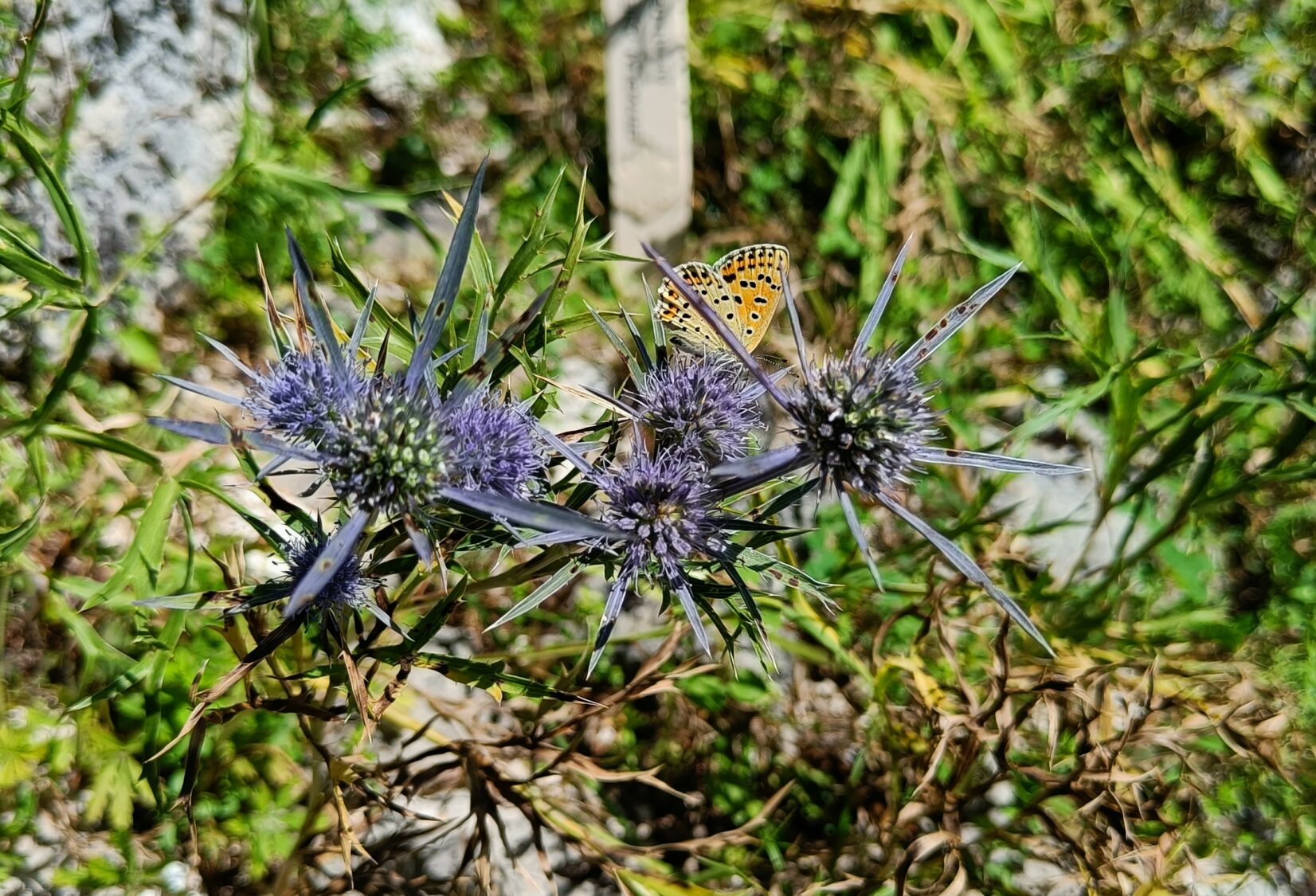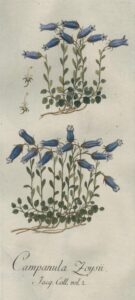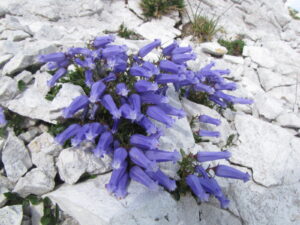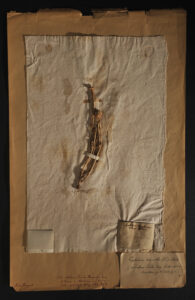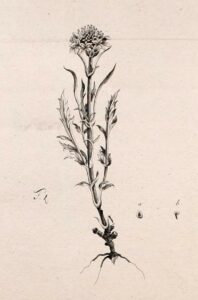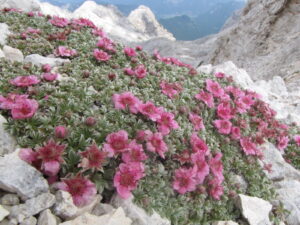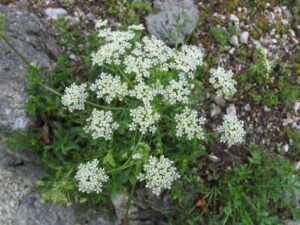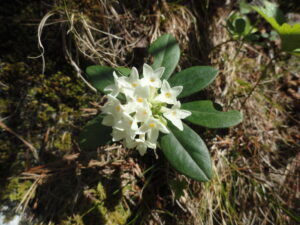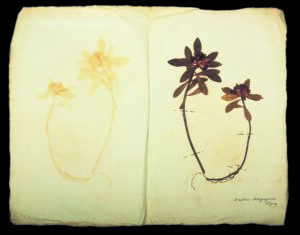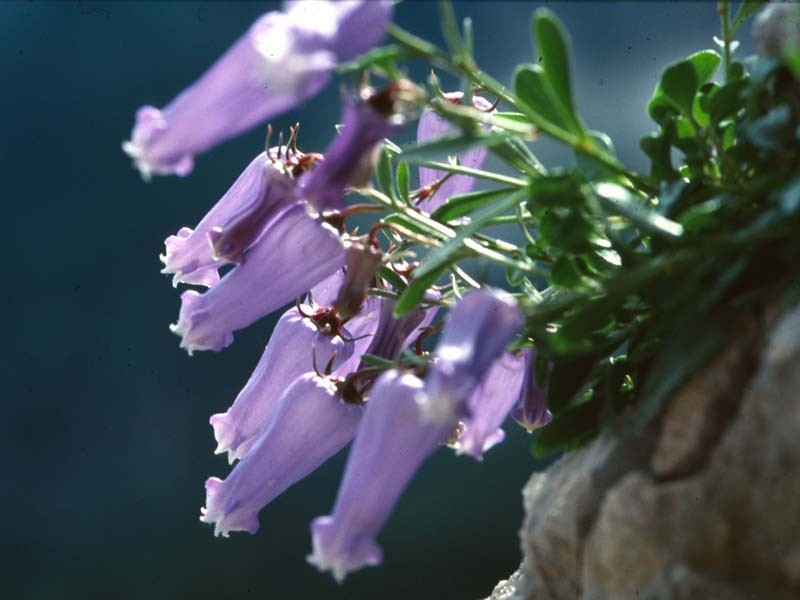
Zois' Bellflower (Foto C. Mlinar)
In Juliana, about 600 different plant species can be found.
Despite some deficiencies that cannot be avoided, it does contain the most characteristic and most beautiful examples of the flora of the Slovene Alps, foothills, and the karst. You can read more about them in the guidebook The Juliana Alpine Botanical Garden in the Trenta Valley (2000). We will mention here only some of them.
“The lofty, glittering crests of Prisojnik, the Velika Dnina’s mighty depths, and the tower-like parapets of Lepa Špica gaze into the Juliana Garden. The panorama from the Garden extends far into both reaches of the valley. This mountain jewel is bounded by the jutting rock walls of the golden alpine meadows and the steep forests, gigantic cushions lying against the soaring slopes and reaching down into the blue ravines. It is as if all the overwhelming beauty of Trenta was gathered around this mountain Garden, encircling it as a magnificent crown. May the benevolent stars continue to protect the Garden!”
Julius Kugy: Toil, Music, the Mountains
Zois' path
You are welcome to take a walk along Zois’ path in the Alpine Botanical Garden Juliana. It is intended especially for families and older primary and secondary school children. Along the path, you will get some information on the establishment of the garden and its gardeners, and will also be acquainted with some special plants. If you click on the speaker icon, the voice of Zoisy the dwarf will accompany you. The dwarf sometimes helps the gardeners but also causes mischief to them here and there.
If you scan the QR code at Juliana with your mobile phone or tablet computer, a single page of the path opens.
Zois' Bellflower
Zois’ Bellflower (Campanula zoysii) is tiny and delicate, that grows from bare rock. Its blue blossoms are most unusual. The mouth of the corolla is not open as is usual in other bellflowers but is narrowed. It grows only in the southwestern limestone Alps and is a true daughter of the Slovene Alps as described by the botanist Viktor Petkovšek. The botanist Karel Zois (1756-1799) found the bellflower in the Bohinj Alps and on Mt Storžič. He sent it to the Klagenfurt (Austria) botanist F. X. Wulfen who named the flower after its original finder: We owe our first knowledge of this very rare plant to the well-known noble, Mr. Karl Zois, who has dedicated himself to Botany, offers it his undivided attention, effort, time, and undoubtedly not a little money. Zois’ bellflower’s outer morphological structure alerts us to the fact that this is a very ancient plant, a relict of the Terciary Period, one of the most beautiful and most characteristic of the Slovene endemites. The flower’s occurrence extends into the Carnic Alps in the west, the Zillian Alps to Dobrač, and to Trnovo Forest in the south. Zois’ Bellflower could be our symbol of the Slovenian Alps.
Zois’ bellflowers decorate rocky crevasses, while the grasslands and gravels of the central Karawanken Mountains are covered with the most beautiful child of our mountains, the little yellow Zois’ Violet (Viola zoysii). Such was the enthusiastic name given it by its godparent, Wulfen, in a scientific description. The plant was discovered in approximately 1785 by Baron Karel Zois. Zois sent to Klagenfurt (Austria) the unknown plant, alive, still in the soil, from the Carniolan Alps which border Carinthia. Wulfen named the Zois’ violet after its discoverer and added a hand-painted drawing to its description.
Scabiosa trenta
The famous Scabiosa trenta, the Scabious of Trenta, is a flower that became the symbol of Kugy’s youthful searchings. This mysterious plant was found in the second half of the eighteenth century by Balthasar Hacquet (1739 or 1740 – 1851), one of the first natural scientists to study the Slovene flora. In 1782 Hacquet described the Scabious of Trenta in his work Carniolian Alpine Plants (Plantae alpinae Carniolicae), writing that it grew in the Trenta mountains. He also added a drawing of the plant he found, and collected a specimen for his herbarium.
Thereafter, the Scabious of Trenta mysteriously disappeared. Many botanists searched for it, but to no avail. Almost a hundred years later the Trieste botanist Muzio Tommasini brought this unsolved enigma to the attention of young Kugy.
A small, slender apparition, a delicate calyx of shimmering silver, a light, white flowery robe embroidered with golden pistils. This was not a blossom–this was a princess from Never-Never Land. Surrounded by its scent, unknown and enticing, it stood on ancient, faded parchment.
This image brought Kugy to Trenta, the legendary kingdom of the Zlatorog. Later he was to sadly sigh: These mountains have made a gift to me of every rare flower. Only the one I searched for-that one not. The cold, rational understanding of the scientist won out over the dreamy soul of the mountain poet.
The Austrian botanist Anton Kerner did not look for the Scabious of Trenta in the mountains, but instead went to Ljubljana, to the dusty herbarium in the Carniolan Municipal Museum, where Hacquet’s specimen was housed. He concluded that the mysterious scabious of Trenta was in fact the common pale “round-head” or the “white tuft” (Cephalaria leucantha), in German Weisser Schuppenkopf that grows in the commons of the karst and on sunny rocks in the submediterranean floral belt. In Slovenia, its locations are known as Socerb, Movraž, and Sočerga. The Scabious of Trenta is a relic of the warmer Interglacial Age when the submediterranean flora extended deep into the heart of the Alps. Once the climate again changed, the majority of the plants died out, leaving only a few in the most favorable sites. It is, therefore, possible that Hacquet found the last specimens of this species which his followers could not as in the meantime it had died out. The white tuft in Juliana blossoms in September and October when its pale yellow rounded inflorescences enliven the flower bed otherwise containing flowers not in season to blossom. The plants grown in Juliana have been raised in a garden setting since the times of Albert Bois De Chesne, who cultivated the white tuft from Devin seeds.
Scabiosa trenta… Kugy’s heart gives a quiet smile… In his faithfulness, he believes in it, albeit the flower may be unattainable…
Triglav Flower
The Rose Cinquefoil or the Triglav Flower (Potentilla nitida)grows on rock and is a cushion-forming silvery-haired plant. In the Juliana, it only flowers every now and then and its pale blossoms are only a dim reflection of the Zlatorog’s crimson-red drops of blood scattered over the gravel of the highest peaks. It has its associations in the subnivale belt below the snow line. It is quite frequent in the Julian Alps and can be found in the Karawanken in Mts Vrtača and Kepa, and on Mt Grintovec in the Kamnik Alps. But to all Slovenes it is and always will be the Zlatorog’s flower: In his greed, Man shot this white chamois with his golden horn just to acquire his gold treasure.
A miraculous blossom arose from the droplets of his blood, and its flowers and silver leaves cured the Zlatorog. In his fury, he hurled the hunter into the abyss and destroyed his own gardens. This legend stresses the ties between Man and Nature: Nature is kind to a man if a man is respectful towards her. But on him who breaks all laws, she will revenge herself and at the same time find enough strength to call into being new life from the dying droplets of blood.
Hladnikia
While it is easy to miss the white-flowering umbelliferous plant with its single or double pinnate leaves, it is well worth a close examination. The Hladnikia (Hladnikia pastinacifolia) was named after the first Slovene botanist and founder of the Botanical Garden in Ljubljana, Franc Hladnik (1773-1844), who discovered it on Mt Čaven in 1819, but it was only described and named after its finder in 1831.
It is the only endemite among the Slovene flora for it differs so greatly from neighboring species that it is considered to be representative of a monotypic species. The hladnikia is 15 to 30 cm high, with pinnate basal leaves, their shiny green segments are ovoid and jagged. The white flowers are in an umbel. It’s not fussy about sites and can grow amidst grasses as well as on rocky clefts. It flourishes in the Trnovo Forest, between Čaven and Kucelj to the south and Zeleni rob and Poldanovec to the north.
As an ancient endemite, it is considered a rare species on the Red List. In the Juliana Garden, it has spread from its original flower bed and we can often see it growing successfully along many paths.
Blagay's Daphne
By the water trough, we find small, prostrate, shrublets with evergreen leaves. The Blagay’s Daphne (Daphne blagayana) blooms in the spring, and its pale yellow blossoms have an intoxicating scent. Of all the plants in Slovenia, this one has undoubtedly received the most attention in writing. On May 22, 1837, a farmer brought a small branch of yellow daphne from Gora to the Earl of Polhov Gradec, Rihard Ursini.
Henrik Freyer (1802-1866), then curator of the Carnelian Regional Museum, described the daphne as a new species and named it Daphne blagayana after the earl. On May 14, 1938, the Saxony king Frederik Avgust II, more interested in botany than his royal duties, came to see the pretty pale daphne and even climbed onto Gora above Polhov Gradec. In the autumn of the same year, Blagay erected a unique monument that still today reminds us of the lofty royal visit. Hence also the Slovene name of the “king’s flower”.
At the time the discovery of this new species aroused great interest among botanists in Europe, as for almost twenty years no additional growth sites were known. Only later was it determined that the Blagay’s daphne extends throughout dry pine tree forests in Croatia, Bosnia and Herzegovina, Serbia, Montenegro, Albania, Macedonia, Bulgaria, Greece, and the Carpathian Mountains. The plant represents a true Illyrian-Carpathian species.
A few years ago its northwesternmost growth site was found in the foothills of the Carnic Alps in Italy. In Slovenia, it grows in the Trebuša Valley, in the Polhograjski Dolomiti, along the lower branch of the Sava River, in Kozjansko, and along the Kolpa River.
Carniolan Primrose
The Carniolan Primrose (Primula carniolica) has scarlet red, pink blossoms and gentle, shiny leaves that are not “flour-dusted”, as the bear’s ear. This flower was known to the natural scientists A. Scopoli and F. X. Wulfen, although they did not consider it to be a new species. The Carniolan primrose was only described by the Viennese botanist Jacquin, to whom B. Hacquet had sent the flower, mistakenly saying it grew in the Carniolan Alps – an error, as it does not flourish in the Alps. Of all the primroses growing in Slovenia, it is the most “Slovenian”, as it cannot be found outside the country’s borders. The flower is one of the most beautiful, young, progressive endemites with an extremely narrow range of growth; it grows in damp and shady gorges at the northern foothills of the Dinaric mountains and south of Ljubljana. Its best-known sites are in the Trnovo forest; the surroundings of Idrija, Trebuša, and Cerkno; near Ribnica and Sodražica in the Dolenjska region, near Cerkno in the Notrajnska region; in the Iški Vintgar near Ljubljana; Iška, the Borovnica Pekel, and in Zaplana. In the Gorenjska region, it grows in the valley of the Sovre above Žiri. The Carniolan primrose is protected, although it is classified in the Red List as a non-threatened plant.
On Jelenk by Idrija and on the north slopes of the Trnovo Forest, a location where the bear’s ear and Carniolan primrose grow together, a hybrid named the “Idrija” Primula (Primula x venusta) is found.
Albert Bois de Chesne had planned to have some foreign plants also present in the Garden.
The Karst and alpine plants that grow together by the sheer, rocky slope by the fence form a living portrait reminding us that nature knows no firm boundaries.
